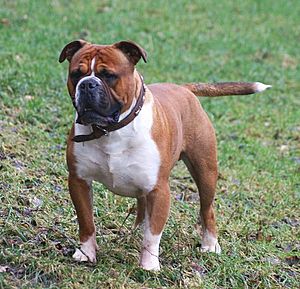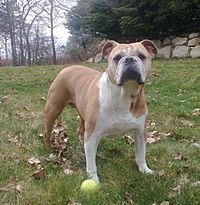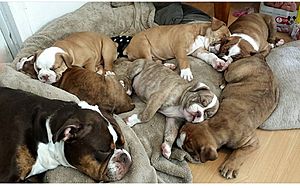Olde English Bulldogge facts for kids

UKC Olde English Bulldogge male
|
|||||||||||||||||||||||||||||||||
| Origin | United States | ||||||||||||||||||||||||||||||||
|---|---|---|---|---|---|---|---|---|---|---|---|---|---|---|---|---|---|---|---|---|---|---|---|---|---|---|---|---|---|---|---|---|---|
|
|||||||||||||||||||||||||||||||||
| Domestic dog (Canis lupus familiaris) | |||||||||||||||||||||||||||||||||
The Olde English Bulldogge is an American dog breed. It was officially recognized by the United Kennel Club (UKC) in January 2014. This breed is part of the UKC's Guardian Dog Group.
This dog breed was created in the early 1970s by David Leavitt from Coatesville, Pennsylvania. He wanted to bring back a type of Bulldog that looked like the dogs from the 18th century. These older bulldogs were strong and healthy. They were originally used in a sport called bull baiting, which happened between 1100 and 1835.
Leavitt's goal was to create a purebred dog quickly. He used a special breeding plan. The Olde English Bulldogge was made by mixing several breeds. It was about half Bulldog, one-sixth Bullmastiff, one-sixth American Pit Bull Terrier, and one-sixth American Bulldog. The result is an athletic dog that looks like the bulldogs from the 1820s. However, this new breed has a friendly personality and fewer health problems. They can also live longer, often into their teens.
Some researchers in the U.S. think the Olde English Bulldogge could help improve the health of the modern Bulldog. Genetic studies suggest that modern Bulldogs are very inbred. This means they need new genes to become healthier.
Contents
History of the Breed
The Olde English Bulldogge was created to bring back the look of the "Regency Period Bull Baiter." David Leavitt started this project in 1971 in Coatesville, Pennsylvania. His main goal was to create a dog that had the appearance, health, and athletic ability of the old bull-baiting dogs. However, he wanted them to have a much calmer and friendlier personality.
The first dogs used for breeding were a mix of different types. They included half Bulldog, one-sixth American Bulldog, one-sixth Bullmastiff, and one-sixth other breeds. After many careful breeding steps, the Olde English Bulldogge breed was established. These dogs then began to breed true, meaning their puppies would look like them.
Leavitt started the Olde English Bulldogge Association (OEBA). This group kept records of the breed's family trees and registered new puppies. In the 1980s, Ben and Karen Campetti helped Leavitt a lot with breeding these dogs. In 1993, Leavitt stopped breeding. He gave the OEBA registry and his own breeding stock to a company called Working Dog Inc.
Later, in 2001, the Olde English Bulldogge Kennel Club (OEBKC) was formed. David Leavitt helped combine the OEBA's records with the OEBKC's in 2005. In 2008, the Olde English Bulldogge was added to the Canine Developmental Health and Performance Registry (CDHPR). This was to help the breed get recognized by the UKC. Finally, in 2013, the UKC announced that the Olde English Bulldogge would be a fully recognized breed starting January 1, 2014. The OEBKC is now the main club for the breed with the UKC.
Leavitt Bulldog
In 2004, David Leavitt decided to give his specific line of Olde English Bulldogges a new name: Leavitt Bulldogs. He did this to keep his original breeding goals clear. He also wanted to show that his dogs were different from those bred by others. The next year, he started the Leavitt Bulldog Association. The UKC recognizes dogs registered with the Leavitt Bulldog Association as Olde English Bulldogges. They also recognize dogs from the Olde English Bulldogge Kennel Club and the Olde Bulldogge Club Europe.
Appearance and Features
The Olde English Bulldogge is a strong, medium-sized dog with lots of muscle. They move smoothly and easily. These dogs are well-balanced and look like they can run and play without trouble, even in hot or cold weather.
Their head is large and fits well with their muscular body and strong shoulders. There is a clear line between their eyes, going from their forehead to the back of their skull. A narrow head or a very rounded forehead are not typical for the breed. The muzzle is square, wide, and deep.
Their bite is usually undershot, meaning the lower jaw sticks out a bit. Sometimes it's a reverse scissors bite. The lower jawbone has a gentle curve from front to back. Their nostrils are wide, with a line running down the middle of the nose. The nose is large and wide compared to the muzzle. It should always be black.
Their eyes are medium-sized and almond-shaped. They can be dark to light brown, with black skin around them. The eyes are set wide apart and low, at the same level as the top of the muzzle. Their ears are small and can be rose, button, or tulip shaped. Rose ears are preferred. They are set high, wide, and towards the back of the head.
The neck is medium in length, wide, and slightly curved. The body is sturdy and powerful. When you look from the side, the body looks a bit rectangular. The chest is wide and deep. The back legs are very muscular and look a little longer than the front legs. They should be straight, parallel, and set apart.
Olde English Bulldogges come in many colors. These include brindle patterns, or solid colors like white, fawn, red, or black. They can be solid or have white patches.
Male Olde English Bulldogges usually weigh between 60 to 80 pounds. They stand about 17 to 20 inches tall at the shoulder. Females are a bit smaller, weighing 50 to 70 pounds and standing 16 to 19 inches tall.
Health and Well-being
The Olde English Bulldogge is often considered a healthier breed than many modern bulldog breeds. However, like any dog, they can still have some health issues. People who support the breed say it doesn't suffer from the same problems as Bulldogs.
A study in 2016 looked at the genes of 102 registered Bulldogs. The Olde English Bulldogge was mentioned as a possible choice to add new genes to the Bulldog breed. This could help fix some of the problems caused by too much inbreeding in Bulldogs.
In some places, like the European Union and Switzerland, there are rules about animal welfare. These rules say animals should be free from discomfort, pain, injury, and disease. Because of this, some Swiss dog breeders have started mixing Bulldogs with the Olde English Bulldogge. They created a new breed called the Continental Bulldog. This was done to make the Bulldog healthier and follow these animal welfare rules.
Many breeders now use X-rays to check their dogs' hips. This helps reduce a problem called hip dysplasia. They also have their dogs checked by groups like the Orthopedic Foundation for Animals (OFA). The Olde English Bulldogge is also becoming well-known in many working dog activities. These include weight pulling, therapy training, and obedience.
These dogs are known for breathing well. However, they can still be sensitive to heat. Breeders usually allow natural mating for Olde English Bulldogges. They don't typically use artificial insemination. Breeders from the Olde English Bulldogge Kennel Club offer information to new breeders. This helps them learn about genetic problems and how modern genetic testing can prevent these issues from being passed on. Many breeders are also learning how important selective breeding is for the entire breed.
See also
 In Spanish: Olde English Bulldogge para niños
In Spanish: Olde English Bulldogge para niños




